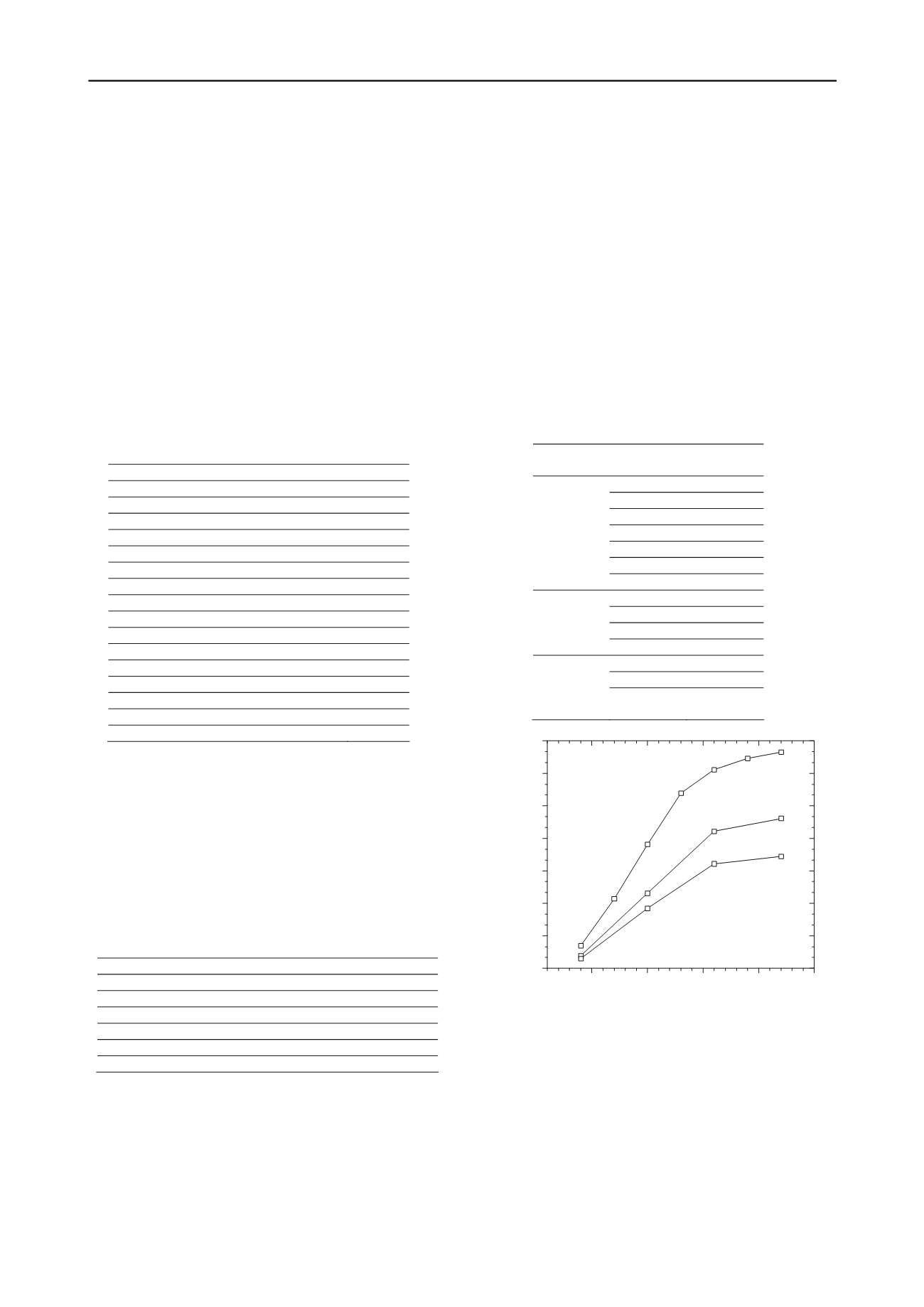
2458
Proceedings of the 18
th
International Conference on Soil Mechanics and Geotechnical Engineering, Paris 2013
Proceedings of the 18
th
International Conference on Soil Mechanics and Geotechnical Engineering, Paris 2013
developed for a particular soft soil, its versatility is
demonstrated for a wide range of soils. A generalized strength
equation is presented, which allows the strength prediction
based, at lower limit, on a single unconfined compression test.
2 EXPERIMENTAL TESTS
2.1
Materials
Table 1 presents the geotechnical and chemical properties of the
soft soil deposit of “Baixo Mondego” (located near Coimbra
city, Portugal), used in the study. In general, the soil is
predominantly clayey-silt with a high organic matter content,
which has a strong influence on some characteristics of the soil,
namely, low unit weight, high plasticity, high natural water
content, high void ratio, low undrained shear strength and high
compressibility although this fact is not consistent with the
grain size distribution, particularly due to the low clay content,
(Coelho 2000, Venda Oliveira et al. 2010).
Table 1. Principal properties of the soft soil of “Baixo Mondego”.
Natural water content, w
nat
(%)
80
Unit weight,
sat
(kN/m
3
)
14.6
Natural void ratio, e
nat
(-)
2.1
Clay fraction (%)
8-12
Silt fraction (%)
71
Sand fraction (%)
17-21
Density, G (-)
2.55
Organic matter content, OM (%)
9.3
Liquid limit, w
L
(%)
71
Plastic limit, w
P
(%)
43
Undrained shear strength, c
u
(kPa)
< 25
CaO (%)
0.74
SiO
2
(%)
62
Al
2
O
3
(%)
16
Fe
2
O
3
(%)
4.8
MgO (%)
1.1
pH (-)
3.5
The binders used in the present study to produce stabilized
“Baixo Mondego” soft soil samples were a Type I Portland
cement, designated CEM I 42.5 R (EN 197-1 2000), and a blast
furnace granulated slag, here simply designated as SLAG.
These two binders, on a dry weight proportion of 75/25 as
proposed by Correia (2011), were thoroughly mixed to obtain a
uniform binder. The binder added to the soil was defined by the
parameter binder content, a
w
(ratio of the dry weight of binder
used in the mixture to the dry weight of the soil). The
composition and the specific surface of the binders are
presented in Table 2.
Table 2. Composition and specific surface of the binders.
CEM I 42.5R
SLAG
CaO (%)
63.02
37.02
SiO
2
(%)
19.70
38.74
Al
2
O
3
(%)
5.23
11.59
Fe
2
O
3
(%)
2.99
0.85
MgO (%)
2.38
6.75
Specific surface, S (m
2
/kg)
321.5
363.0
2.2
Chemical stabilization of the soft soil of “Baixo
Mondego”
In order to evaluate the influence of the water content and
binder content on the chemical stabilization of the soft soil of
“Baixo Mondego”, several samples were prepare for various
water contents (equivalent to a liquidity index I
L
of 1.35, 1.96
and 2.49) and binder contents (from 9 to 27, step 3). The
laboratorial procedure to produce stabilized samples followed
the laboratory procedure presented in EuroSoilStab (2001) with
the modifications proposed by Correia (2011). During the
curing time, fixed as 28 days, all samples were subjected to a
vertical pressure of 24 kPa and stayed submerged in a water
tank at a controlled temperature (20±2ºC). After this period, the
samples were submitted to the unconfined compression test in
order to evaluate its strength (q
u max
).
Tabel 3 and Figure 1 summarizes the main results of the
chemical stabilization of the soft soil of “Baixo Mondego”. The
results show that, as expected, the unconfined compressive
strength increases with the binder content and with the
decreasing of the water content (or liquidity index). As the
binder content increases, more binder is admixed with the soil
allowing the construction of a stronger skeleton matrix. As the
water content increases the void ratio also increases, promoting
the particles’ spacing with obvious reflects on the fabric of the
stabilized soil and on its strength.
Table 3. Unconfined compressive strength results of the chemical
stabilization of the soft soil of “Baixo Mondego”.
I
L
a
w
q
u max
(-)
(%)
(kPa)
1.35
9
209
12
644
15
1143
18
1618
21
1831
24
1936
27
1995
1.96
9
118
15
694
21
1266
27
1383
2.49
9
90
15
552
21
965
27
1032
0
300
600
900
1200
1500
1800
2100
I
L
= 2.49
I
L
= 1.96
q
u max
(kPa)
I
L
= 1.35
10
15
20
25
30
a
w
(%)
Figure 1. Unconfined compressive strength results of the chemical
stabilization of the soft soil of “Baixo Mondego”.
From Figure 1 it can be seen that the curves for different
liquidity index exhibit a similar shape (are homothetic). Thus
the unconfined compressive strength (q
u max
) can be normalised
by the liquidity index (I
L
) multiplying both parameters (q
IL
=
q
u max
× I
L
). Figure 2 presents these results which are well fitted
by a linear logarithmical regression. This is a simple way to
predict the unconfined compressive strength at 28 days of
curing time for the cement based stabilized softy soil in study.
As it is a linear regression it only requires two test data made
for different binder contents.


